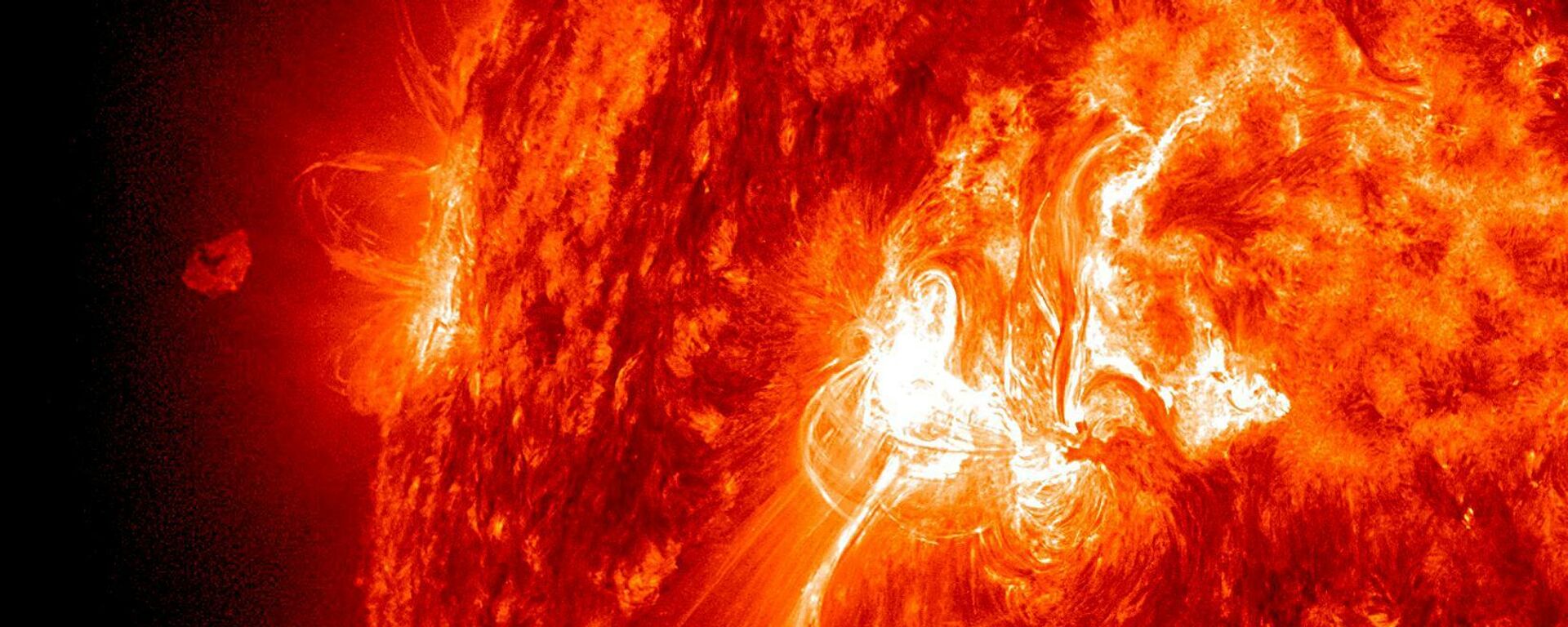https://sputnikglobe.com/20230805/astronomers-detect-unprecedented-record-breaking-gamma-rays-emitted-by-sun-1112402161.html
Astronomers Detect Unprecedented, Record-Breaking Gamma Rays Emitted by Sun
Astronomers Detect Unprecedented, Record-Breaking Gamma Rays Emitted by Sun
Sputnik International
Contrary to expectations, the extraordinary burst of energy did not correspond to any heightened solar activity; the Sun was surprisingly calm at the time of the detection.
2023-08-05T02:00+0000
2023-08-05T02:00+0000
2023-08-05T02:00+0000
beyond politics
science & tech
sun
solar energy
space
space exploration
https://cdn1.img.sputnikglobe.com/img/07e7/08/05/1112402003_29:0:473:250_1920x0_80_0_0_3c9b987644b828c612a6b9fac43d73f5.png
In a groundbreaking discovery, solar physicists detected the most energetic light ever observed emanating from the sun, raising new questions about our home star's behavior. The observation was made during a near decadelong campaign involving over 30 institutions across three continents - North America, Europe, and Asia, and it marked the first-ever detection of solar gamma radiation in the teraelectron volt (TeV) range.The High Altitude Water Cherenkov (HAWC) observatory in Mexico proved instrumental in the discovery. HAWC is one of the few detectors capable of observing the sun in the TeV range, allowing continuous exposure as the sun moves across the sky.The data collected from 2014 to 2021 revealed emissions ranging from 0.5 to 2.6 TeV coming from the direction of the sun. Researchers concluded that an emission reading originated from the sun, with a 6.3 sigma probability.While not the highest-energy light ever detected in space (that record belongs to gamma rays from the Crab Nebula), the findings are unprecedented for our own star.Researchers speculate the TeV emission could be a result of galactic cosmic rays colliding with nuclei in the solar atmosphere. Similar to how cosmic rays interact with Earth's atmosphere to produce a gamma ray glow, a comparable process might be occurring on the sun.However, the exact mechanism behind the phenomenon remains unknown and does not align with current theoretical models. It is suspected that the sun's messy magnetic fields may play a crucial role, possibly acting as accelerators for cosmic ray electrons to generate synchrotron gamma radiation.Further modeling and research will be needed to fully comprehend the puzzling phenomenon. The observations underscored the necessity for a revised framework that can account for the anomalous excess of gamma rays from the sun, not only in the giga-electron volts range but also in the TeV range.The research was published in the Physical Review Letters journal.
https://sputnikglobe.com/20230727/eureka-scientists-find-out-why-suns-corona-registers-hotter-than-solar-surface-1112169526.html
Sputnik International
feedback@sputniknews.com
+74956456601
MIA „Rossiya Segodnya“
2023
News
en_EN
Sputnik International
feedback@sputniknews.com
+74956456601
MIA „Rossiya Segodnya“
Sputnik International
feedback@sputniknews.com
+74956456601
MIA „Rossiya Segodnya“
sun radiation, does sun emits radiation, why is the sun radiation, does the sun carry radiation, solar radiation, high altitude water cherenkov, hawc observation, gamma radiation teraelectronvolt tev range, solar activity
sun radiation, does sun emits radiation, why is the sun radiation, does the sun carry radiation, solar radiation, high altitude water cherenkov, hawc observation, gamma radiation teraelectronvolt tev range, solar activity
Astronomers Detect Unprecedented, Record-Breaking Gamma Rays Emitted by Sun
Contrary to expectations, the extraordinary burst of energy did not correspond to any heightened solar activity; in fact, the sun was surprisingly calm at the time of the detection. The unexpected revelation has left scientists baffled, as current models of the sun cannot explain the phenomenon.
In a groundbreaking discovery, solar physicists detected the most energetic light ever observed emanating from the sun, raising new questions about our home star's behavior.
The observation was made during a near decadelong campaign involving over 30 institutions across three continents - North America, Europe, and Asia, and it marked the first-ever detection of solar gamma radiation in the teraelectron volt (TeV) range.
The High Altitude Water Cherenkov (HAWC) observatory in Mexico proved instrumental in the discovery. HAWC is one of the few detectors capable of observing the sun in the TeV range, allowing continuous exposure as the sun moves across the sky.
"We now have observational techniques that weren’t possible a few years ago... In this particular energy regime, other ground-based telescopes couldn’t look at the sun because they only work at night. Ours operates 24/7," said Mehr Un Nisa, a post-doctoral research associate at Michigan State University and co-author of the study.
The data collected from 2014 to 2021 revealed emissions ranging from 0.5 to 2.6 TeV coming from the direction of the sun. Researchers concluded that an emission reading originated from the sun, with a 6.3 sigma probability.
While not the highest-energy light ever detected in space (that record belongs to gamma rays from the Crab Nebula), the findings are unprecedented for our own star.
Researchers speculate the TeV emission could be a result of galactic cosmic rays colliding with nuclei in the solar atmosphere. Similar to how cosmic rays interact with Earth's atmosphere to produce a gamma ray glow, a comparable process might be occurring on the sun.
However, the exact mechanism behind the phenomenon remains unknown and does not align with current theoretical models. It is suspected that the sun's messy magnetic fields may play a crucial role, possibly acting as accelerators for cosmic ray electrons to generate synchrotron gamma radiation.
Further modeling and research will be needed to fully comprehend the puzzling phenomenon. The observations underscored the necessity for a revised framework that can account for the anomalous excess of gamma rays from the sun, not only in the giga-electron volts range but also in the TeV range.
The sun, being the most extensively studied star in the cosmos, remains enigmatic, with many aspects of its processes still eluding scientists. While magnetic fields are known to play a significant role in solar activity, the underlying mechanisms are poorly understood.
Researchers rely on studying the light emitted by the sun to gain deeper insights into its workings.
The research was published in the
Physical Review Letters journal.



